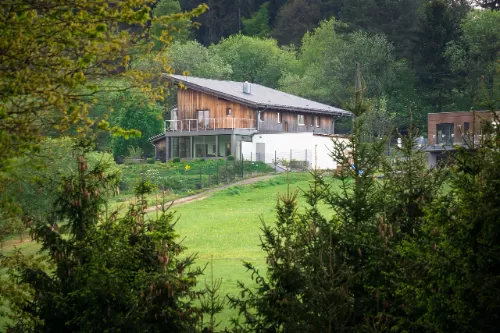

Click to Get Big Benefits

Escape Without Sacrifice
At its heart, the modern country house is a rebellion against the rush. City dwellers tired of honking horns and tiny balconies are heading for the hills – but they’re not leaving their comforts behind. High-speed internet, radiant floor heating, solar panels – these are now as common as fire pits and rocking chairs. This new wave of homeowners wants the peace of country living, but they’re also taking Zoom calls and streaming 4K movies. The house becomes a sanctuary and a workspace – a place where chickens roam outside, but your groceries still arrive via app.
Design That Breathes
One of the defining features of modern country homes is their relationship with the landscape. These aren’t houses trying to conquer the land – they’re working with it. Architects are leaning into natural materials: oak, stone, and clay, often sourced from nearby. Large windows frame views of rolling hills or wild meadows, and outdoor spaces like covered porches and fire patios blur the line between inside and out. The result? Homes that don’t just sit on the land, they belong there. It’s rustic, yes – but elevated. Think more “Kinfolk” than “cowboy.”
The Kitchen Is the Soul
In both traditional and modern country homes, the kitchen is the beating heart – but the style has changed. You’ll still find hearty wooden tables and open shelving, but they’re now paired with brushed brass fixtures, smart induction ranges, and artisanal tilework. It’s where form meets function in a meaningful way. Homeowners want to preserve that down-to-earth cooking spirit – fresh herbs on the windowsill, sourdough on the rise – but without the clutter. The vibe is less farmhouse kitsch, more intentional simplicity. A space to cook, gather, and slow down.
Old Bones, New Soul
Not all modern country houses are built from scratch. Many are reimagined farmhouses, barns, or stone cottages, lovingly restored with a clean, contemporary twist. A centuries-old barn might now house an open-plan living room with steel beams and concrete floors. That old hayloft? Maybe it’s a sleek reading nook now. The goal isn’t to erase the past – it’s to let it live alongside the present. These homes tell stories: of resilience, craftsmanship, and the beauty of imperfection. You’ll find antique doors next to hidden storage, and hand-hewn beams beneath skylights.
Sustainability as a Way of Life
For many, moving to the country isn’t just about style – it’s about values. Modern country homes often prioritize sustainability, not just in the materials but in how the house functions day to day. Solar panels, geothermal heat, rainwater collection systems – these aren’t trends, they’re conscious choices. The idea is to live closer to the land in every sense, reducing impact while still living beautifully. Garden beds replace manicured lawns. Compost bins are standard. And even the architecture is often passive solar, making the most of light, shade, and airflow.
Room to Think, Space to Feel
One thing that separates a country house from a city apartment is, quite simply, space. Modern country homes make that space feel intentional. High ceilings, wide hallways, reading alcoves, window benches – there’s room to pause, reflect, breathe. Bedrooms aren’t just sleeping quarters, but sanctuaries. Living rooms are designed for conversation, not just TV viewing. There’s an emotional spaciousness to these homes, a kind of openness that invites a slower rhythm of life. It’s less about square footage, more about mental room to stretch out.
Country Living, Modern Mindset
Today’s modern country dwellers aren’t just retirees or off-grid dreamers. They’re designers, software developers, chefs, families with school-aged kids. They’re people looking to reconnect – with nature, with their partners, with themselves. And their homes reflect that shift. These houses aren’t staging grounds for a rustic fantasy. They’re real, lived-in spaces – places where you can plant vegetables and binge Netflix, host dinner parties and hear owls at night. It’s a lifestyle that merges intention with indulgence, where simplicity doesn’t mean sacrifice.
Conclusion
Modern country houses represent a new American dream. Not the white-picket-fence-in-the-suburbs version, but something quieter, more grounded. A life where the air is clear, the nights are dark, and the home reflects both who you are and who you want to become. Whether it’s a blackened cedar cabin in the Catskills, a metal-roof farmhouse in Montana, or a mid-century modern lodge tucked into the woods of Oregon – the modern country house isn’t just a place to live. It’s a way to live. And more people, it seems, are choosing that path every day.

All News
Others
- Terms of use
- Privacy Policy